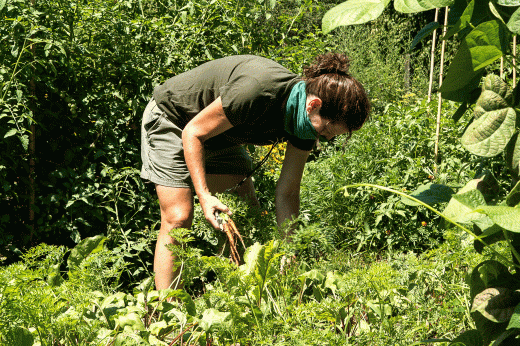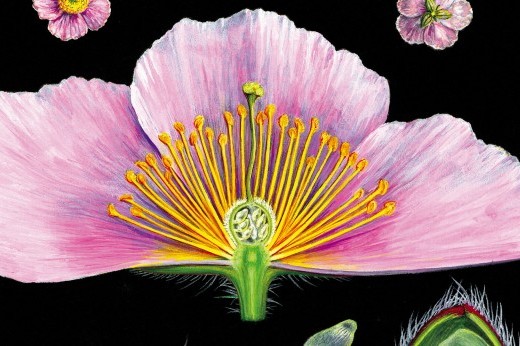This is not the first time Brooklyn Botanic Garden has faced a pandemic. The Garden was founded in 1910, and just a short while later, the influenza pandemic of 1918 emerged in the United States. At that time, the effects of flu were very much intertwined with World War I, as well as with other devastating illnesses.
Brooklyn Botanic Garden did not close that year because of the flu or even in prior and future years because of polio. But the Garden’s school group attendance dropped to near zero in October 1918 because of the pandemic. The conservatories also closed, though for a different reason, and much like now, the Garden grew food to address shortages.
The economy was in tatters then due to the war. The flu pandemic was devastating, but it was the war that dominated the headlines in the earlier stages, and then the armistice in 1918. Wartime security concerns even delayed sharing information about the onset of the pandemic with the public. Imagine living through the dark days of a long war only to face an epidemic of epic proportions.
At the Garden, the conservatories were closed to the public at times in 1918 and 1919, but because of a wartime coal shortage that endangered the plants. As much as possible, areas of the conservatories were shut off. Then, space permitting, the plants were “moved in” together into what was then called the Economic House and two wings. Despite those measures, the Garden was still not able to generate enough heat to maintain the plants perfectly, but a surprising number survived, albeit with many a lost leaf. Not deterred by this crisis, the staff decided to collect hardiness data on the plants.
Outside of the Garden, the pandemic was at its most intense in New York City in the fall of 1918. The Brooklyn Daily Eagle and New York Times headlines are eerily similar to today’s headlines and reflect similar controversies.
A public health campaign advocating hand-washing, covering one’s mouth with a handkerchief when coughing, and abstaining from spitting was already in place because of the prevalence of tuberculosis. Laws had been enacted against spitting; these laws and general sanitary measures were increasingly enforced and followed as the 1918 pandemic intensified.
People were advised to wear masks made of medical gauze, which to us today sounds alarmingly permeable. Many people made masks for themselves and others, but often used material that was probably ineffectual—cheesecloth for instance! Poor mask design and improper use caused the the strategy to largely fail.
In cities across the nation, officials made controversial decisions about the cancellation of events and closures of schools, restaurants, theaters, stores, churches, and other venues, having a similar impact on the economy then as now.
In New York, businesses staggered their hours, theaters their schedules. Ushers escorted theatergoers with coughs out of the audience. Schools remained open. This was done to protect children since conditions at school were likely more sanitary than in many homes.
The Brooklyn Daily Eagle and the New York Times noted postponements and cancellations of events of all kinds—parades in Queens, the tour of the Paris Conservatory Orchestra, a Mother’s Meeting at PS 128, religious conventions, mass at some churches, football games, draft inductions, teachers’ folk dance classes. There were also school closures in various nearby districts.
Given the seriousness of the wartime effort—work or fight—larger recreational events like baseball were already controversial and becoming more so; in 1918 the baseball season was shortened because of the war effort, not the flu. The World Series was played in Boston that year, a city badly hit by the pandemic; the Brooklyn Dodgers, not in the series that year, had played through the league season.
There was so much less known about virology at that time. In his 2012 book, Spillover: Animal Infections and the Next Human Pandemic, David Quammen gives context:
Viruses couldn’t be viewed with an optical microscope, they couldn’t be grown in a culture of chemical nutrients; they couldn’t be captured, as bacteria could, with a porcelain filter. They could only be inferred.
Food security and other economic fallout were major issues then as they are now. Throughout the Garden’s history in times of crisis, the institution has refocused resources on instruction for growing food or even distributing food. During World War I, horticulture staff planted “war gardens” in the Children’s Garden, not unlike this year’s Children’s Garden plots devoted to raising food for the Campaign Against Hunger. Staff members were also permitted to have plots on-site.
The Garden distributed over 311,000 penny packets of seeds. The intent at the time was to get all available land into cultivation. There came to be less demand for flowers and more demand for vegetables, with requests for onion seed packets rising from an average of one thousand per year to six thousand per year. The education department ran an extensive program on farming vacant lots, and one of the Garden’s demonstration programs was filmed by the then major news service Hearst-Pathé.
Printed articles were distributed that sound a lot like some of BBG’s present-day web content. There were a host of articles in the Brooklyn Botanic Garden Leaflet series on vegetable gardening, canning, and fertilizers for city gardens. Ellen Eddy Shaw, the BBG educator who founded the Children’s Garden, wrote an article on the impact of wartime on children’s gardening. In that piece, she described the botany and gardening lessons that could be learned from an “ordinary war garden.” How poignant, the word ordinary.
During this period, the Garden’s science department researched castor beans for the USDA; these were important because of their oil, which was used as an airplane lubricant and in other commercial products.
Sadly, the son of the Garden’s first president, Charles Stuart Gager, likely died due to the epidemic. City records report that he died at age 14 in June 1918 of a pneumonia-like illness. None of the sources available provide much detail, but the flu was present in the city and he was in the age range most affected by the disease.
To me, the biggest takeaway in my research was that the Garden always adhered to its horticultural and educational mission even when directing its efforts to food security. This held true through the Depression, World War II, and beyond. I think we combine those missions even now in this current historic moment.



